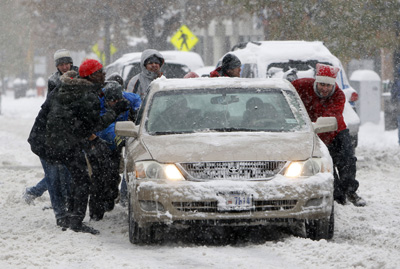
The Northeast is getting a big 20-inch snowfall and — let’s face it — we’re using the opportunity to “tsk tsk” what a big deal they’re making out of it. Fact is: We like to think we know snow better than the northeast knows snow, but we don’t.
Check the average snow forecast map.


We rarely have snowfalls at least a foot deep in the Twin Cities anymore. In the last decade, the northeast averages more than three such storms a year. And snow there isn’t the same as snow here. Our colder-than-anywhere temperatures creates a light, fluffier snow. That makes for more blizzards, but easier shoveling. The East has the ocean, which makes every shovelful of snow a heart attack waiting to happen.
Snow also fell in Washington and the mid-Atlantic states. Big deal? Sure it is, when you don’t have the snowfighting equipment the snowbelt has.
The mean snowfall amount per year in Minneapolis is 39.5 inches. That’s less than Boston’s 40.7. The heaviest snowfall per season in Boston was 86.5 inches in 2005. Minneapolis’ heaviest snowfall year was also 2005, according to the National Weather Service. It got 42.8 inches of snow. (Note: I’m not sure how NOAA calculates these numbers because the National Weather Service in Chanhassen has much different seasonal snowfall amounts for Minnesota, but presumably NOAA uses the same method for both locations)
The Weather Service also calculates the “big deal factor” of snowfalls by the number of people in a storm’s path. The East Coast wins there easily. There are many more flights a day at East Coast airports, so the effect of snow is more pronounced.
Why is a snowstorm on the East Coast being made into such a big deal? Because it’s a big deal. And if it happened here, we’d be making a big deal of it, too.
Our specialty, of course, is cold. The time to appropriately snicker is when the East Coast complains about 20 degree weather in December or January. And you know they will.
